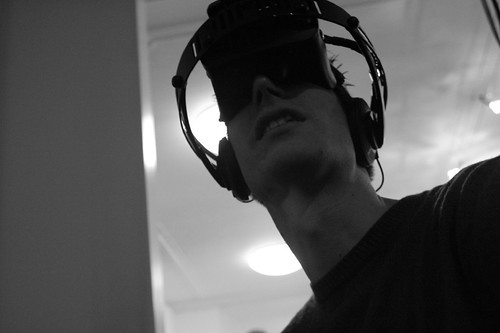As Harold Tan, one of the summit organizers, noted when talking about why immersive technology is important, life is about experiences, and technology can be used to immerse yourself in other people’s experiences; you can live a hi-res depiction of an artist’s imagination.
Though I was only able to attend the morning sessions, I was pleased to note how many projects have nonprofit applications. I’ll share some of the highlights here.
Fred Nikgohar of RoboDynamics described how robots are being used to bring people together across time and space. Robots are serving as a mobile telepresence to bring together geographically dispersed talent within a workplace, or to allow an out-of-town manager to be present to oversee his employees on the factory floor. Fred noted that it only takes an average of five days for staff to make the mental adjustment of referring to the robot representation by the remote employee’s name. This has obvious applications for telemedicine and education in geographically remote areas.
Mark Bolas at USC’s Institute for Creative Technology demonstrated how his lab is creating virtual environments for training and simulations, transforming real space into a walkable virtual location using virtual reality headsets and warehouse space. Military and hospital simulations stretch space through redirection tricks like flipping the door to a different wall without the user noticing to minimize the physical space needed. One of the demonstrations in the exhibit hall showed another way of allowing the user to explore a virtual location with a stationary hamster ball-type of apparatus synched with the view in the VR goggles.
Bonnie Bucker and Garry Hare of Imagined Communities talked about their design-based educational experience that connects students with their communities. After rendering their neighborhood in 3-D, youth identify areas of need in the community to reimagine how it could be improved. For example, a blighted area could be turned into a community garden. The youth give virtual walking tours of the neighborhood, and residents can vote on the changes they like the most. The new design can then be realized in the real world. I loved when Garry said, “I’m interested in the political troublemaking aspects of augmented reality.”
Jacquelyn Ford Morie, also from USC’s Institute of Creative Technologies, talked about the virtual humans and avatars the ICT has created for various purposes. She demonstrated Ada and Grace, the virtual human museum guides at the Boston Museum of Science. They can understand and respond to natural spoken language, engaging visitors in both explaining the science exhibits and in demonstrating applied computer science.
In addition, ICT created the “Coming Home” project (also known as Transitional Online Post-Deployment Soldier Support in Virtual Worlds), which provides mental health support to returning soldiers in Second Life. This virtual veterans center provides real-time in-world stress reduction and mindfulness classes and areas where soldiers can come together for peer support. This includes the Warrior’s Journey – a narrative component where individuals’ avatars enter a tower and follow their choice of classic warrior stories from various cultures that depict values like duty and dedication. At the end of the journey, they meet the avatar of that character and can have a conversation with him. This is an opportunity for returning soldiers to “rewrite” and reframe their own personal stories, which they may feel conflicted about. They can then add their own story online by uploading pictures and text.
I think the technology is getting to a point where nonprofits can start looking at whether the immersive approach can help them further their goals. As a panelist noted, when “Jackass 3D” gets the highest weekly box-office ratings, it means that immersive media is making its way to the mainstream. I’m sure we can find better uses than that!
For more reading on augmented reality:
- How nonprofits are using augmented reality – Geoff Livingston
- Augmented reality business models – Gary Hayes
- Augmented reality platforms and mlearning – Dianne Rees
- Ambient Intelligence and Immersive Virtual Telepresence in Health Care – Giuseppe Riva
Photo Credit: janjochemo


 Nedra helps nonprofits and public agencies create positive change on health and social issues through social marketing and transmedia storytelling strategies at Weinreich Communications since founding the company in 1995. She helps organizations make a difference for the populations they serve by strategically designing programs that draw on state-of-the-art behavior change techniques, digital media approaches and the power of stories.
Nedra helps nonprofits and public agencies create positive change on health and social issues through social marketing and transmedia storytelling strategies at Weinreich Communications since founding the company in 1995. She helps organizations make a difference for the populations they serve by strategically designing programs that draw on state-of-the-art behavior change techniques, digital media approaches and the power of stories. 